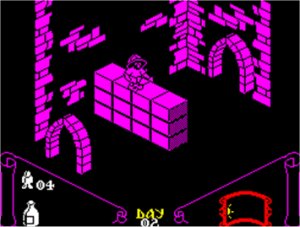Sinclair Mk14 - 1978
A Quantum Leap

By 1984, the Spectrum was really being seen as a games computer. Its funny keyboard and small screen were severe limitations and seeing one extended out the back with 3 or even 4 devices plugged in was interesting to say the least!
Sinclair BASIC was now one of the least powerful in terms of what has become to be known as "structured programming" and the lack of a proper high definition colour screen meant that games were really reaching the point where they could not be improved any further (look at something like Knight Lore to see how far graphics could be pushed but notice that the high-res centre screen could only be done in one colour).
Sinclair's answer was the QL (Quantum Leap). The name was corny but it offered a sexy black shape with two built-in microdrives, a fairly decent keyboard (with no keyword system) and a very comprehensive BASIC. It ought to have sold much better than it did apart from suffering from early-release syndrome. Many companies had pre-released their new computers in the hope of capturing early sales, the Oric-1 and the Newbrain both come to mind. In many cases, the result was essentially a no-show with orders being on delayed delivery for weeks or even months. In Sinclair's case, they managed to ship the unit though with some major problems. The first was that they intended to fit the software onto a 32KB ROM but it was too large to fit. Instead, the first models went out with another ROM stuck on the back in a "dongle". Much worse, the early ROMs contained a number of bugs.
The system came with 128KB of memory and two internal microdrives. It also had an 80 character-wide high-resolution screen. The problems above though, plus initial stock shortages plus an entry price of £399 really finished the computer before it started and it never really made the sales it deserved. Fast forward a few more years, the ROM was now all internal, the bugs were fixed and the price had dropped to £200 and it was an extremely good computer. Other companies supplied many additional features; my own had 256KB of memory (it was possible to go up to 640KB, more than the first IMB PC had to offer) plus twin floppy drives. You could even get hard drives as well as modems etc.
The version of BASIC on the QL was easily a match for the accepted standard of BBC BASIC. Not only that but you could buy BASIC compilers which turned the easy to program and test but slow to execute BASIC into very fast machine code. It came with high resolution graphics and a fairly reasonable keyboard.
The QL could have been one of the best computers of the decade had it been properly sorted from the beginning.
